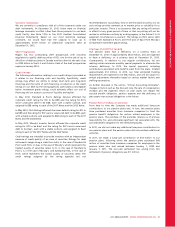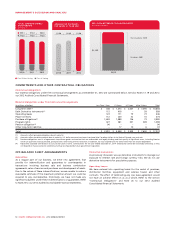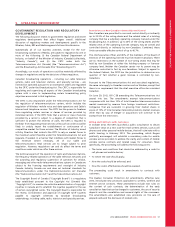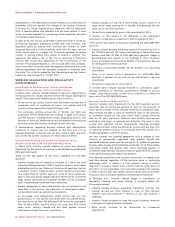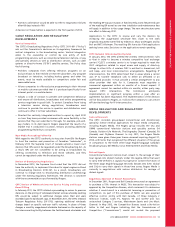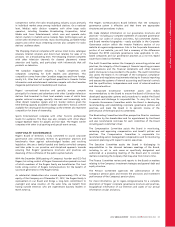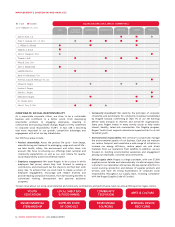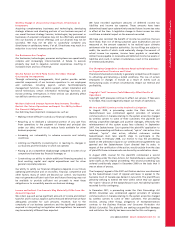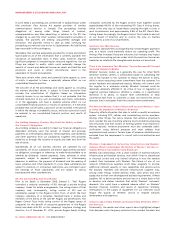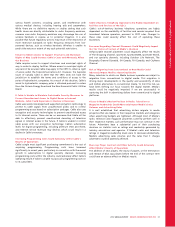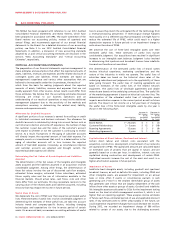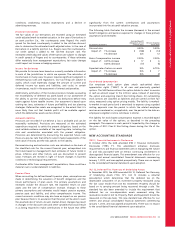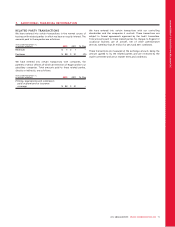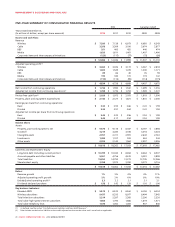Rogers 2012 Annual Report Download - page 67
Download and view the complete annual report
Please find page 67 of the 2012 Rogers annual report below. You can navigate through the pages in the report by either clicking on the pages listed below, or by using the keyword search tool below to find specific information within the annual report.
MANAGEMENT’S DISCUSSION AND ANALYSIS
ENTERPRISE RISK MANAGEMENT
Rogers is committed to strengthening its risk management
capabilities to protect and enhance shareholder value. The purpose of
risk management is not to eliminate risk but to optimize trade-offs
between risk and return to maximize value to the organization.
The Enterprise Risk Management program at Rogers seeks to ensure
that there is consistency to the methods used in identifying, assessing,
managing, monitoring and communicating risks throughout the
Company and that risk management efforts are aligned with the
Company’s vision, mission, values, strategic and business objectives.
Risk Management Process
A Strategic Risk Assessment process is conducted on an annual basis to
identify and assess the key risks facing Rogers and their potential
impact on the achievement of the Company’s strategic plans. Key
inputs into this assessment include prior risk and audit reports,
industry benchmarks, risk management interviews with key risk
owners and a formal risk survey with management. Emerging risks are
included in the assessment, and risks are prioritized using standard
risk assessment criteria.
Results of the Strategic Risk Assessment are reported to the
Company’s senior management and to the Audit Committee of the
Board. Enterprise Risk Management monitors the progress of risk
management plans for key risks and reports on the status to senior
management.
These key risks are used as the basis for pushing down the focus of
functional and operational risk management at the business unit
level. A formal risk survey is conducted bi-annually to get feedback
from management on the key risks facing the organization and to
assist in the identification of emerging risks.
The corporate and operational functions monitor the key risks and
the related risk mitigation activities on an ongoing basis to be certain
that the risk mitigation strategies are effective in managing the risk.
Regular updates on the key risks and the related ongoing risk
mitigation activities are communicated to Enterprise Risk
Management and the responsible Senior Leadership Team.
Risk assessment is being formally incorporated into Rogers’ strategic
planning, business planning and internal audit planning processes.
Risk Governance
The Board is responsible, in its governance role, for overseeing
management with respect to its responsibility for identifying principal
risks and for the implementation of appropriate risk assessment
processes to manage these risks. The Audit Committee supports the
Board through its responsibility to discuss policies with respect to risk
assessment and risk management. In addition, the Audit Committee is
responsible for assisting the Board in the oversight of compliance
with legal and regulatory requirements. The Audit Committee also
reviews with senior management the adequacy of the internal
controls that have been adopted to safeguard assets from loss and
unauthorized use, to prevent, deter and detect fraud and to verify
the accuracy of the financial records and review any special audit
steps adopted in light of material weaknesses or significant
deficiencies that might be identified.
The Executive Leadership Team is responsible for approving enterprise
risk policies and for the identification, assessment and mitigation of
key risks that impact the Company’s ability to meet its objectives. It is
also responsible for monitoring key risks and action plans on an
ongoing basis.
The Senior Leadership Team and Line Management are responsible for
the identification, assessment, management and monitoring of business
unit level risks impacting strategy and business plans and reporting to
the Executive Leadership Team and Enterprise Risk Management.
Enterprise Risk Management supports the Audit Committee and the
Board’s responsibility for risk by facilitating a formal Strategic Risk
Assessment process. In addition, Internal Audit conducts a fraud risk
assessment to identify those areas in which significant financial
statement fraud could occur and to ensure that any identified fraud
risks of this nature are mitigated by documented and verified
controls. Rogers Enterprise Risk Management methodology and
policies enable a consistent and measurable approach to risk
management, which relies on the expertise of our management and
employees to identify risks and opportunities as well as implement
risk mitigation strategies as required.
RISKS AND UNCERTAINTIES AFFECTING OUR
BUSINESS
This section describes the principal risks and uncertainties that could
have a material adverse effect on the business and financial results of
the Company and its subsidiaries.
We Are Subject to General Economic Conditions
Our businesses are affected by general economic conditions and
consumer confidence and spending. Recessions, declines in economic
activity and economic uncertainty can erode consumer and business
confidence and reduce discretionary consumer spending. Any of these
factors may negatively affect us through lower demand for our
products and services, including decreased advertising, revenue and
profitability, increased churn and higher bad debt expense. A
significant proportion of Media’s Broadcasting, Publishing and Digital
revenues are derived from the sale of advertising, which is highly
dependent on general economic conditions.
Poor economic conditions may also have an impact on our pension
plans, as there is no assurance that the plans will be able to earn the
assumed rate of return. As well, market-driven changes may result in
changes in the discount rates and other variables that would result in
Rogers being required to make contributions in the future that differ
significantly from the current contributions and assumptions
incorporated into the actuarial valuation process.
We Face Substantial Competition
The competition facing our businesses is described in the section
“Competition in our Businesses”. There can be no assurance that our
current or future competitors will not provide services superior to
those we provide, or at lower prices, adapt more quickly to evolving
industry trends or changing market requirements, enter the market in
which we operate, or introduce competing services. Any of these
factors could reduce our market share or revenues, or increase churn.
Wireless anticipates some ongoing re-pricing of the existing
subscriber base as lower pricing offered to attract new customers is
extended to or requested by existing customers. As wireless
penetration of the population deepens, new wireless customers may
generate lower average monthly revenues than those generated from
existing customers, which could slow revenue growth.
Wireless could face increased competition as a result of recent
changes to foreign ownership and control of wireless licences. This
could result in foreign telecommunication companies entering the
Canadian wireless communications market, through the acquisition of
either wireless licences or a holder of wireless licences. The entry into
the market of such companies with significantly greater capital
resources than Rogers could reduce Wireless’ market share and cause
Wireless’ revenues to decrease significantly. See the section
“Restrictions on Non-Canadian Ownership and Control” under
“Government Regulation and Regulatory Developments”.
2012 ANNUAL REPORT ROGERS COMMUNICATIONS INC. 63


